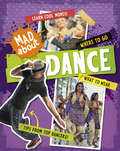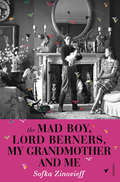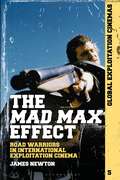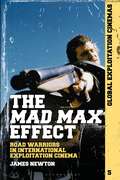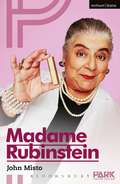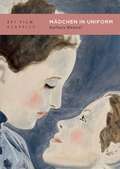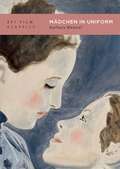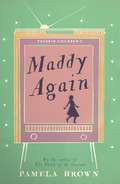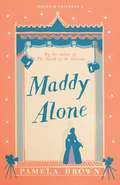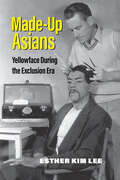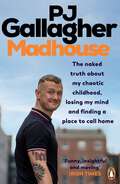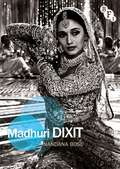- Table View
- List View
Mad About: Dance (PDF)
by Hachette BooksIf you're mad about dance, this book will help you make the most of your favourite hobby. Find out how to perfect your skills, whether you're dancing salsa, ballroom, tap or bhangra, and expand your abilities into taking part in dance shows and competitions.
The Mad Boy, Lord Berners, My Grandmother And Me: An Aristocratic Family, A High-society Scandal And An Extraordinary Legacy
by Sofka ZinovieffFaringdon House in Oxfordshire was the home of Lord Berners, composer, writer, painter, friend of Stravinsky and Gertrude Stein, a man renowned for his eccentricity – masks, practical jokes, a flock of multi-coloured doves – and his homosexuality. Before the war he made Faringdon an aesthete’s paradise, where exquisite food was served to many of the great minds, beauties and wits of the day. Since the early thirties his companion there was Robert Heber-Percy, twenty-eight years his junior, wildly physical, unscholarly, a hothead who rode naked through the grounds, loved cocktails and nightclubs, and was known to all as the Mad Boy. If the two men made an unlikely couple, at a time when homosexuality was illegal, the addition to the household in 1942 of a pregnant Jennifer Fry, a high society girl known to be ‘fast’, as Robert’s wife was simply astounding.After Victoria was born the marriage soon foundered (Jennifer later married Alan Ross). Berners died in 1950, leaving Robert in charge of Faringdon, aided by a ferocious Austrian housekeeper who strove to keep the same culinary standards in a more austere age. This was the world Sofka Zinovieff, Victoria’s daughter, a typical child of the sixties, first encountered at the age of seventeen. Eight years later, to her astonishment, Robert told her he was leaving her Faringdon House.Her book about Faringdon and its people is marvellously witty and full of insight, bringing to life a vanished world and the almost fantastical people who lived in it.
The Mad Max Effect: Road Warriors in International Exploitation Cinema (Global Exploitation Cinemas)
by James NewtonThe Mad Max Effect provides an in-depth analysis of the Mad Max series, and how it began as an inventive concoction ofa number of influences from a range of exploitation genres (including the biker movie, the revenge film, and the car chasecinema of the 1970s), to eventually inspiring a fresh cycle of international low budget 'road warrior' movies that appeared on home video in the 1980s.The Mad Max Effect is the first detailed academic study of the most famous and celebrated post-apocalypse film series, andexamines how a humble Australian action movie came from the cultural margins of exploitation cinema to have a profound impact on the broader media landscape.
The Mad Max Effect: Road Warriors in International Exploitation Cinema (Global Exploitation Cinemas)
by James NewtonThe Mad Max Effect provides an in-depth analysis of the Mad Max series, and how it began as an inventive concoction ofa number of influences from a range of exploitation genres (including the biker movie, the revenge film, and the car chasecinema of the 1970s), to eventually inspiring a fresh cycle of international low budget 'road warrior' movies that appeared on home video in the 1980s.The Mad Max Effect is the first detailed academic study of the most famous and celebrated post-apocalypse film series, andexamines how a humble Australian action movie came from the cultural margins of exploitation cinema to have a profound impact on the broader media landscape.
Mad Men: Dream Come True TV (Reading Contemporary Television)
by Gary R. EdgertonEvery few years a new television program comes along to capture and express the zeitgeist. Mad Men is now that show. Since premiering in July 2007, it's won numerous awards, is syndicated across the globe, and its imprint is evident throughout contemporary culture. Series' creator Matthew Weiner, a former exec producer on The Sopranos, presents another set of compelling, complex characters. They are living out the American dream. Then why are they so unhappy? Why is their 'dream come true' not enough? Mad Men explores, analyses and celebrates this cutting edge TV drama and popular phenomenon. It also includes an interview with the show's Executive Producer Scott Hornbacher and an episode guide.
Mad Men and Politics: Nostalgia and the Remaking of Modern America
by Lilly J. Goren Linda BeailMad Men, using the historical backdrop of the many events that came to demarcate the 1960s, has presented a beautifully-styled rendering of this tumultuous decade, while teasing out a number of themes that resonate throughout the show and connect to the contemporary discourses that dominate today's political landscape. The chapters of this book analyze the most important dimensions explored on the show, including issues around gender, race, prejudice, the family, generational change, the social movements of the 1960s, our understanding of America's place in the world, and the idea of work in the post-war period. Mad Men and Politics provides the reader with an understanding not only of the topics and issues that can be easily grasped while watching, but also contemplates our historical perspective of the 1960s as we consider it through the telescope of our current condition.
Mad Men and Politics: Nostalgia and the Remaking of Modern America
by Lilly J. Goren Linda BeailMad Men, using the historical backdrop of the many events that came to demarcate the 1960s, has presented a beautifully-styled rendering of this tumultuous decade, while teasing out a number of themes that resonate throughout the show and connect to the contemporary discourses that dominate today's political landscape. The chapters of this book analyze the most important dimensions explored on the show, including issues around gender, race, prejudice, the family, generational change, the social movements of the 1960s, our understanding of America's place in the world, and the idea of work in the post-war period. Mad Men and Politics provides the reader with an understanding not only of the topics and issues that can be easily grasped while watching, but also contemplates our historical perspective of the 1960s as we consider it through the telescope of our current condition.
Madame Rubinstein (Modern Plays)
by John MistoSet against the glamorous skylines of 1950s Manhattan, world-leading cosmetics entrepreneur Helena Rubinstein is locked in a power struggle with rivals Elizabeth Arden and Revlon.From humble beginnings as a Polish-Jewish immigrant, this is the story behind one of the best-known faces in the world of beauty. But as her professional and family conflicts reach fever pitch, will the ghosts of a turbulent past topple one of the world's richest businesswomen?Madame Rubinstein is a bright new comedy where the nails are painted and the gloves are off. Yet when the lipstick bleeds and the makeup fades, what is there left to hide behind?Written by esteemed Australian playwright John Misto, this edition of the text was published to coincide with its 2017 run at the Park Theatre, London.
Madame Rubinstein (Modern Plays)
by John MistoSet against the glamorous skylines of 1950s Manhattan, world-leading cosmetics entrepreneur Helena Rubinstein is locked in a power struggle with rivals Elizabeth Arden and Revlon.From humble beginnings as a Polish-Jewish immigrant, this is the story behind one of the best-known faces in the world of beauty. But as her professional and family conflicts reach fever pitch, will the ghosts of a turbulent past topple one of the world's richest businesswomen?Madame Rubinstein is a bright new comedy where the nails are painted and the gloves are off. Yet when the lipstick bleeds and the makeup fades, what is there left to hide behind?Written by esteemed Australian playwright John Misto, this edition of the text was published to coincide with its 2017 run at the Park Theatre, London.
Mädchen in Uniform (BFI Film Classics)
by Barbara MennelLeontine Sagan's Mädchen in Uniform (1931) is a groundbreaking German film that showcases women's agency and desire behind and in front of the camera.Adapted from Christa Winsloe's lesbian play, the story follows Manuela, an orphan in a boarding school for impoverished Prussian nobility. When she declares her love with her female teacher, the oppressive principal punishes her, leading to a desperate suicide attempt.Barbara Mennel's compelling study firmly establishes Mädchen in the Weimar cinema canon. Mennel contextualises the film in 1920s theories of sexuality and the conventions of modernist cinema. She contrasts its international success to the extensive censorship battles that surrounded it. The film's unique transnational and fragmented history results from the exile of many of its makers during the Nazi regime. By attending to the many remakes throughout the 20th and 21st century, Mennel underscores the film's timeless impact that continues to resonate with contemporary audiences.
Mädchen in Uniform (BFI Film Classics)
by Barbara MennelLeontine Sagan's Mädchen in Uniform (1931) is a groundbreaking German film that showcases women's agency and desire behind and in front of the camera.Adapted from Christa Winsloe's lesbian play, the story follows Manuela, an orphan in a boarding school for impoverished Prussian nobility. When she declares her love with her female teacher, the oppressive principal punishes her, leading to a desperate suicide attempt.Barbara Mennel's compelling study firmly establishes Mädchen in the Weimar cinema canon. Mennel contextualises the film in 1920s theories of sexuality and the conventions of modernist cinema. She contrasts its international success to the extensive censorship battles that surrounded it. The film's unique transnational and fragmented history results from the exile of many of its makers during the Nazi regime. By attending to the many remakes throughout the 20th and 21st century, Mennel underscores the film's timeless impact that continues to resonate with contemporary audiences.
Maddy Again (Blue Door #5)
by Pamela BrownThe fifth and final book in the Blue Door series, which starts with The Swish of the Curtain, the classic story that inspired actors from Maggie Smith to Eileen Atkins'I wanted to act before I read this book, and afterwards there was no stopping me' Maggie SmithMaddy got up and did her Junior Miss speech, trying not to overdo the comedy. Her American accent was hideous, and very funny, and all the class began to giggle. They clapped when she had finished, and Mr Manyweather roared with laughter 'What a little horror!' he cried. 'I've never seen anything so nauseating, but excellent!'Maddy is on her own again at the Actors' Guild in London, while the others work at the Blue Door Theatre. But she's not entirely alone: she has a new roommate, a new chaperone and an inspiring new teacher, Mr Manyweather, brought in to introduce students to the exciting world of television.With these new friends, can Maddy survive her first taste of failure – or is she embarking on her greatest acting adventure yet?Pamela Brown (1924–1989) was a British writer, actor then television producer. She was just fourteen when she started writing her first book, and the town of Fenchester in the book is inspired by her home town of Colchester. During the Second World War, she went to live in Wales, so The Swish of the Curtain was not published until 1941, when she was sixteen. She used the earnings from the books to train at RADA, and became an actor and a producer of children's television programmes.
Maddy Alone (Blue Door #2)
by Pamela BrownThe second book in the Blue Door series, following on from The Swish of the Curtain, the classic story which inspired actors from Maggie Smith to Eileen Atkins“I wanted to act before I read this book, and afterwards there was no stopping me” Maggie SmithAll that lay ahead were examinations and then the blankness of the holidays. For the hundredth time Maddy thought, ‘Oh, why am I only twelve? Why do the others always do all the exciting things before me?’Stuck at home while the older members of the Blue Door Theatre Company attend London’s Actors’ Guild, Maddy is lonely and frustrated. Under some gentle advice from the Bishop, she finds her way onto the set of a film being shot at a local castle, and works her usual charm on the cast and crew.But will this opportunity realise Maddy’s dreams of becoming an actress — or will it end her career before it has even begun?Pamela Brown (1924–1989) was a British writer, actor then television producer. She was just fourteen when she started writing her first book, and the town of Fenchester in the book is inspired by her home town of Colchester. During the Second World War, she went to live in Wales, so The Swish of the Curtain was not published until 1941, when she was sixteen. She used the earnings from the books to train at RADA, and became an actor and a producer of children's television programmes.
Made In Scotland: My Grand Adventures in a Wee Country
by Billy ConnollyAll roads lead home.‘After my knighthood was announced, a woman from the BBC came to Glasgow to interview me. We sat down in a lovely hotel in a nice part of town, and she hit me with her first question: “This must mean a lot to you, with you coming from nothing?” I looked at her, and I laughed.“I did’nae come from nothing,” I told her. “I come from something.”I grew up in the tenements of post-war Glasgow. I am very proud to be working class, and especially a working-class Glaswegian who has worked in the shipyards. I come from the working class. And, most of all, I come from Scotland.Scotland is a unique and wonderful place. Its national motto says a lot about it: Nemo me impune lacessit. A decent translation might be: ‘By all means punch me in the nose but prepare yourself for a kick in the arse.’I did’nae come from nothing: I come from Scotland. And this book is about why I will always be happy and proud that I do.’
Made to Be Seen: Perspectives on the History of Visual Anthropology
by Marcus Banks and Jay RubyMade to be Seen brings together leading scholars of visual anthropology to examine the historical development of this multifaceted and growing field. Expanding the definition of visual anthropology beyond more limited notions, the contributors to Made to be Seen reflect on the role of the visual in all areas of life. Different essays critically examine a range of topics: art, dress and body adornment, photography, the built environment, digital forms of visual anthropology, indigenous media, the body as a cultural phenomenon, the relationship between experimental and ethnographic film, and more. The first attempt to present a comprehensive overview of the many aspects of an anthropological approach to the study of visual and pictorial culture, Made to be Seen will be the standard reference on the subject for years to come. Students and scholars in anthropology, sociology, visual studies, and cultural studies will greatly benefit from this pioneering look at the way the visual is inextricably threaded through most, if not all, areas of human activity.
Made to Be Seen: Perspectives on the History of Visual Anthropology
by Marcus Banks and Jay RubyMade to be Seen brings together leading scholars of visual anthropology to examine the historical development of this multifaceted and growing field. Expanding the definition of visual anthropology beyond more limited notions, the contributors to Made to be Seen reflect on the role of the visual in all areas of life. Different essays critically examine a range of topics: art, dress and body adornment, photography, the built environment, digital forms of visual anthropology, indigenous media, the body as a cultural phenomenon, the relationship between experimental and ethnographic film, and more. The first attempt to present a comprehensive overview of the many aspects of an anthropological approach to the study of visual and pictorial culture, Made to be Seen will be the standard reference on the subject for years to come. Students and scholars in anthropology, sociology, visual studies, and cultural studies will greatly benefit from this pioneering look at the way the visual is inextricably threaded through most, if not all, areas of human activity.
Made to Be Seen: Perspectives on the History of Visual Anthropology
by Marcus Banks and Jay RubyMade to be Seen brings together leading scholars of visual anthropology to examine the historical development of this multifaceted and growing field. Expanding the definition of visual anthropology beyond more limited notions, the contributors to Made to be Seen reflect on the role of the visual in all areas of life. Different essays critically examine a range of topics: art, dress and body adornment, photography, the built environment, digital forms of visual anthropology, indigenous media, the body as a cultural phenomenon, the relationship between experimental and ethnographic film, and more. The first attempt to present a comprehensive overview of the many aspects of an anthropological approach to the study of visual and pictorial culture, Made to be Seen will be the standard reference on the subject for years to come. Students and scholars in anthropology, sociology, visual studies, and cultural studies will greatly benefit from this pioneering look at the way the visual is inextricably threaded through most, if not all, areas of human activity.
Made to Be Seen: Perspectives on the History of Visual Anthropology
by Jay RubyMade to be Seen brings together leading scholars of visual anthropology to examine the historical development of this multifaceted and growing field. Expanding the definition of visual anthropology beyond more limited notions, the contributors to Made to be Seen reflect on the role of the visual in all areas of life. Different essays critically examine a range of topics: art, dress and body adornment, photography, the built environment, digital forms of visual anthropology, indigenous media, the body as a cultural phenomenon, the relationship between experimental and ethnographic film, and more. The first attempt to present a comprehensive overview of the many aspects of an anthropological approach to the study of visual and pictorial culture, Made to be Seen will be the standard reference on the subject for years to come. Students and scholars in anthropology, sociology, visual studies, and cultural studies will greatly benefit from this pioneering look at the way the visual is inextricably threaded through most, if not all, areas of human activity.
Made to Be Seen: Perspectives on the History of Visual Anthropology
by Jay Ruby Marcus BanksMade to be Seen brings together leading scholars of visual anthropology to examine the historical development of this multifaceted and growing field. Expanding the definition of visual anthropology beyond more limited notions, the contributors to Made to be Seen reflect on the role of the visual in all areas of life. Different essays critically examine a range of topics: art, dress and body adornment, photography, the built environment, digital forms of visual anthropology, indigenous media, the body as a cultural phenomenon, the relationship between experimental and ethnographic film, and more. The first attempt to present a comprehensive overview of the many aspects of an anthropological approach to the study of visual and pictorial culture, Made to be Seen will be the standard reference on the subject for years to come. Students and scholars in anthropology, sociology, visual studies, and cultural studies will greatly benefit from this pioneering look at the way the visual is inextricably threaded through most, if not all, areas of human activity.
Made to Be Seen: Perspectives on the History of Visual Anthropology
by Jay Ruby Marcus BanksMade to be Seen brings together leading scholars of visual anthropology to examine the historical development of this multifaceted and growing field. Expanding the definition of visual anthropology beyond more limited notions, the contributors to Made to be Seen reflect on the role of the visual in all areas of life. Different essays critically examine a range of topics: art, dress and body adornment, photography, the built environment, digital forms of visual anthropology, indigenous media, the body as a cultural phenomenon, the relationship between experimental and ethnographic film, and more. The first attempt to present a comprehensive overview of the many aspects of an anthropological approach to the study of visual and pictorial culture, Made to be Seen will be the standard reference on the subject for years to come. Students and scholars in anthropology, sociology, visual studies, and cultural studies will greatly benefit from this pioneering look at the way the visual is inextricably threaded through most, if not all, areas of human activity.
Made-Up Asians: Yellowface During the Exclusion Era
by Esther Kim LeeMade-Up Asians traces the history of yellowface, the theatrical convention of non-Asian actors putting on makeup and costume to look East Asian. Using specific case studies from European and U.S. theater, race science, and early film, Esther Kim Lee traces the development of yellowface in the U.S. context during the Exclusion Era (1862–1940), when Asians faced legal and cultural exclusion from immigration and citizenship. These caricatured, distorted, and misrepresented versions of Asians took the place of excluded Asians on theatrical stages and cinema screens. The book examines a wide-ranging set of primary sources, including makeup guidebooks, play catalogs, advertisements, biographies, and backstage anecdotes, providing new ways of understanding and categorizing yellowface as theatrical practice and historical subject. Made-Up Asians also shows how lingering effects of Asian exclusionary laws can still be seen in yellowface performances, casting practices, and anti-Asian violence into the 21st century.
Madhouse: The naked truth about my chaotic childhood, losing my mind and finding a place to call home
by PJ Gallagher'An absolutely brilliant read' Patrick Kielty, Late Late Show, RTÉ‘Blisteringly honest . . . hilarious, traumatic, joyful and terrifying. Fasten your seatbelts, it’s going to be a bumpy read!’ Liz Nugent'Gloriously unabashed . . . vibrant, poignant and surprisingly hopeful' Irish Times I grew up in a psychiatric experiment crossed with an alcoholic experiment. . . . a place run by two people who were extraordinarily drunk and guarded by a potentially vicious dog with a brain tumour.PJ Gallagher spent much of his childhood knocking back Lucozade with the local alcoholics in his parents' northside pub. But the chaos that reigned for his first ten years was nothing compared to what happened when - having lost the pub - his mum took in six psychiatric patients from the local hospital to give them 'care in the community'.Worst. Idea. Ever.Madhouse is PJ's riotous life story. Covering everything from dogs, motorbikes and the art of small talk, to the lessons of mental breakdown and finally figuring out love, this is PJ unbound. Most surprising - to PJ more than anyone - is the prospect of becoming a dad in his late forties, when he always thought of 'family' as a trap.Madhouse is the funny, insightful and moving story of someone just trying to keep his head above water - and how he is making sense of it all at last!'Terrifically honest, as well as a being funny and sad' Matt Cooper, The Last Word, Today FM 'Delivered in Gallagher’s brilliantly blunt northside brogue, evoking a shade of Roddy Doyle' Irish Independent 'Tells his story with humour and insight making it feel as though you are chatting with an old friend' Irish Examiner'Bold, anarchic . . . relates wild antics and traumas from his tumultuous life with both humour and perceptive clarity' Business Post'So open . . . amazing for understanding and trying to destroy the stigma [of mental health struggles] . . . a great read' Elaine Crowley, Ireland AM, Virgin Media
Madhuri Dixit (Film Stars)
by Nandana BoseA wide-ranging account of the Indian film star Madhuri Dixit, one of the most popular actresses of Hindi cinema. Nandana Bose's study traces Dixit's twenty-five year career, exploring her star persona, her indelible impact on Indian popular culture, and her continuing popularity even in middle age. Nandana Bose discusses Dixit's unusual and distinctive career trajectory that upends pre-existing models of female stardom, by marrying at the peak of her career, withdrawing from the limelight for years, and then returning to extend her career into her early fifties by reinventing herself as a transmedia celebrity for a new generation. However, it is her unique talent as a dancer, and her innovative choreographic styles and repertoire of movements that make her standout from other Hindi film stars. Surveying Dixit's film-making career, Bose argues that she represents a wholesome and traditional figure of femininity that has resonated across class and cultural hierarchies at a time of great economic and social change in India.
Madhuri Dixit (Film Stars)
by Nandana BoseA wide-ranging account of the Indian film star Madhuri Dixit, one of the most popular actresses of Hindi cinema. Nandana Bose's study traces Dixit's twenty-five year career, exploring her star persona, her indelible impact on Indian popular culture, and her continuing popularity even in middle age. Nandana Bose discusses Dixit's unusual and distinctive career trajectory that upends pre-existing models of female stardom, by marrying at the peak of her career, withdrawing from the limelight for years, and then returning to extend her career into her early fifties by reinventing herself as a transmedia celebrity for a new generation. However, it is her unique talent as a dancer, and her innovative choreographic styles and repertoire of movements that make her standout from other Hindi film stars. Surveying Dixit's film-making career, Bose argues that she represents a wholesome and traditional figure of femininity that has resonated across class and cultural hierarchies at a time of great economic and social change in India.
Madly, Deeply: The Alan Rickman Diaries
by Alan RickmanA SUNDAY TIMES BESTSELLER A WATERSTONES BEST BOOK OF 2022: ENTERTAINMENT A MAIL ON SUNDAYS BOOK OF THE YEAR 2022 Alan Rickman remains one of the most beloved actors of all time across almost every genre, from his breakout role as Die Hard’s villainous Hans Gruber to his heart-wrenching run as Professor Severus Snape, and beyond. His air of dignity, his sonorous voice and the knowing wit he brought to each role continue to captivate new audiences today. But Rickman’s artistry wasn’t confined to just his performances. Rickman’s writing details the extraordinary and the ordinary in a way that is anecdotal, indiscreet, witty, gossipy and utterly candid. He takes us behind the scenes on films and plays ranging from Sense & Sensibility, the Harry Potter series, Private Lives, My Name Is Rachel Corrie and many more. The diaries run from 1993 to his death in 2016 and offer insight into both a public and private life. Here is Rickman the consummate professional actor, but also the friend, the traveller, the fan, the director, the enthusiast: in short, the real Alan Rickman. Here is a life fully lived, all detailed in intimate and characteristically plain-spoken prose. Reading the diaries is like listening to Rickman chatting to a close friend. Madly, Deeply also includes a foreword by Emma Thompson and a selection of Rickman’s early diaries, dating from 1974 to 1982, when his acting life first began.
